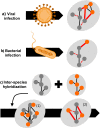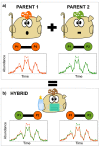Yeast proteins do not practice social distancing as species hybridize
- PMID: 33948708
- PMCID: PMC8096128
- DOI: 10.1007/s00294-021-01188-x
Yeast proteins do not practice social distancing as species hybridize
Abstract
With the current COVID-19 pandemic, we all realized how important interactions are. Interactions are everywhere. At the cellular level, protein interactions play a key role and their ensemble, also called interactome, is often referred as the basic building blocks of life. Given its importance, the maintenance of the integrity of the interactome is a real challenge in the cell. Many events during evolution can disrupt interactomes and potentially result in different characteristics for the organisms. However, the molecular underpinnings of changes in interactions at the cellular level are still largely unexplored. Among the perturbations, hybridization puts in contact two different interactomes, which may lead to many changes in the protein interaction network of the hybrid, including gains and losses of interactions. We recently investigated the fate of the interactomes after hybridization between yeast species using a comparative proteomics approach. A large-scale conservation of the interactions was observed in hybrids, but we also noticed the presence of proteostasis-related changes. This suggests that, despite a general robustness, small differences may accumulate in hybrids and perturb their protein physiology. Here, we summarize our work with a broader perspective on the importance of interactions.
Keywords: Hybridization; Interactome; Protein–protein interaction; Yeast.
© 2021. The Author(s), under exclusive licence to Springer-Verlag GmbH Germany, part of Springer Nature.
Conflict of interest statement
The authors declare that they have no conflict of interest.
Figures


Similar articles
-
Frequent Assembly of Chimeric Complexes in the Protein Interaction Network of an Interspecies Yeast Hybrid.Mol Biol Evol. 2021 Apr 13;38(4):1384-1401. doi: 10.1093/molbev/msaa298. Mol Biol Evol. 2021. PMID: 33252673 Free PMC article.
-
Yeast Interspecies Comparative Proteomics Reveals Divergence in Expression Profiles and Provides Insights into Proteome Resource Allocation and Evolutionary Roles of Gene Duplication.Mol Cell Proteomics. 2016 Jan;15(1):218-35. doi: 10.1074/mcp.M115.051854. Epub 2015 Nov 11. Mol Cell Proteomics. 2016. PMID: 26560065 Free PMC article.
-
Interspecies hybridization and recombination in Saccharomyces wine yeasts.FEMS Yeast Res. 2008 Nov;8(7):996-1007. doi: 10.1111/j.1567-1364.2008.00369.x. Epub 2008 Mar 18. FEMS Yeast Res. 2008. PMID: 18355270 Review.
-
Evolution of a novel chimeric maltotriose transporter in Saccharomyces eubayanus from parent proteins unable to perform this function.PLoS Genet. 2019 Apr 4;15(4):e1007786. doi: 10.1371/journal.pgen.1007786. eCollection 2019 Apr. PLoS Genet. 2019. PMID: 30946740 Free PMC article.
-
Multi-scale perturbations of protein interactomes reveal their mechanisms of regulation, robustness and insights into genotype-phenotype maps.Brief Funct Genomics. 2016 Mar;15(2):130-7. doi: 10.1093/bfgp/elv043. Epub 2015 Oct 17. Brief Funct Genomics. 2016. PMID: 26476431 Review.
Cited by
-
Protein nonadditive expression and solubility contribute to heterosis in Arabidopsis hybrids and allotetraploids.Front Plant Sci. 2023 Sep 14;14:1252564. doi: 10.3389/fpls.2023.1252564. eCollection 2023. Front Plant Sci. 2023. PMID: 37780492 Free PMC article.
References
-
- Bar-Zvi D, Lupo O, Levy AA, Barkai N. Hybrid vigor: the best of both parents or a genomic clash? Curr Opin Syst Biol. 2017;6:22–27. doi: 10.1016/j.coisb.2017.08.004. - DOI
-
- Darwin C. The variation of animals and plants under domestication. Authorized. New York: O. Judd & Company; 1868.
Publication types
MeSH terms
Substances
LinkOut - more resources
Full Text Sources
Molecular Biology Databases

